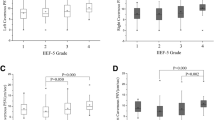Abstract
Purpose: Nocturnal penile tumescence monitoring was compared to cavernosal smooth muscle content in 48 cases of erectile dysfunction.Materials and methods: Pre-operatively nocturnal penile tumescence rigidity (NPTR) testing, colour Doppler sonography and if needed pharmaco cavernosometry-cavernosography were evaluated in 48 impotent patients before surgical intervention. The 40 patients whom all those diagnostic tools were abnormal constituted the first group. In the remaining 8 patients, which constitutes the second group, NPTR testing were normal but the other tests were abnormal. 10 potent patients with congenital penile curvature constituted the third group. Cavernous biopsies were obtained during the surgery and biopsies stained immunohistochemically to quantify smooth muscle cells (SMC) by anti-desmin and anti-SMA.Results: We observed statistical significant difference of corporeal SMC content with regard to first Vs second group and first Vs third group (p < 0.05). However we did not observe statistically significant difference with regard to second vs third group (p > 0.05).Conclusion: NPTR testing appears to correlate well with corporeal SMC, which is the key structures of erection. We think that with taking into the consideration of its specific reservations, NPTR testing is still one of the best non-invasive tool in the differential diagnosis of erectile dysfunction.
Similar content being viewed by others
References
Lue TF, Tanagho EA. Physiology of erection and pharmacological management of impotence. J Urol 1987; 137: 829.
Lue TF, Mueller SC, Jow YR, Hwang TI. Functional evaluation of penile arteries with duplex ultrasound in vasodilator-induced erection. Urol Clin N Amer 1989; 16: 799.
Lowe MA, Schwartz AN, Berger RE. Controlled trial of infusion cavernosometry in impotent and potent men. J Urol 1991; 146: 783.
Karacan I, Hursch CJ, Williams RL. Some characteristics of nocturnal penile tumescence in elderly males. J Gerontol 1972; 27: 39.
Bradley WE, Timm GM, Gallagher JM, Johnson BK. New method for continuous measurement of nocturnal penile tumescence and rigidity. Urology 1985; 26: 4.
Shabsigh R, Fishman IJ, Shotland Y et al. Comparison of penile duplex ultrasonography with nocturnal penile tumescence monitoring for the evaluation of erectile impotence. J Urol 1990; 143: 924.
Allen RP, Engel RME, Smolev JK, Brendler CB. Comparison of duplex ultrasonography and nocturnal penile tumescencen in evaluation of impotence. J Urol 1994; 151: 1525–1529.
Sattar AA, Wery D, Golzarian J et al. Correlation of nocturnal penile tumescence monitoring, duplex ultrasonography and infusion cavernosometry for the diagnosis of erectile dysfunction. J Urol 1996; 155: 1274–1276.
Kessler WO. Nocturnal penile tumescence. Urol Clin N Amer 1988; 15: 81–86.
Montague DK, Lakin MM. False diagnoses of venous leak impotence. J Urol 1992; 148: 148–149.
Lue TF. Impotence: a patient's goal-directed approach to treatment. World J Urol 1990; 8: 67.
Thase ME, Reynolds CF, Jenings JR et al. Nocturnal penile tumescence is diminished in depressed men. Biological Psychiatry 1988; 24: 33–46.
Arver S, Dobs AS, Meikle AW et al. Improvement of sexual function in testosterone deficient men treated for 1 year with a permeation enhanced testosterone transdermal system. J Urol 1996; 155: 1604–1608.
Pressman MR, DiPhillipo MA, Kendrick JI et al. Problems in the interpretation nocturnal penile tumescence studies: disruption of sleep by occult sleep disorders. J Urol 1986; 136: 595–598.
Kirkeby HJ, Pousen EU, Peterson T, Droup J. Erectile dysfunction in multiple sclerosis. Neurology 1988; 38: 1366–1371.
Hatzichristou DG, Hatzimouratidis K, Ioannides E et al. Nocturnal penile tumescence. And rigidity monitoring in young potent volunteers: reproducibility, evaluation criteria and the effect of sexual intercourse. J Urol 1998; 159: 1921–1926.
Wespes E, Goes P, Schiffman S et al. Computerised Analysis of smooth muscle fibbers in potent and impotent patients. J Urol 1991; 146: 1015–1017.
Wespes E, Goes P, Sattar AA, Schulman CC. Objective criteria in the long-term evaluation of penile venous surgery. J Urol 1994; 152: 888–890.
Stief CG, Djamilian M, Truss M et al. Prognostic factors for the postoperative outcome of penile venous surgery for venogenic erectile dysfunction. J Urol 1994; 151: 880–883.
Author information
Authors and Affiliations
Corresponding author
Rights and permissions
About this article
Cite this article
Yılmaz, E., Yaman, Ö., Bozlu, M. et al. Comparison of nocturnal penile tumescence monitoring and cavernosal smooth muscle content in patients with erectile dysfunction. Int Urol Nephrol 34, 117–120 (2002). https://doi.org/10.1023/A:1021327500439
Issue Date:
DOI: https://doi.org/10.1023/A:1021327500439




